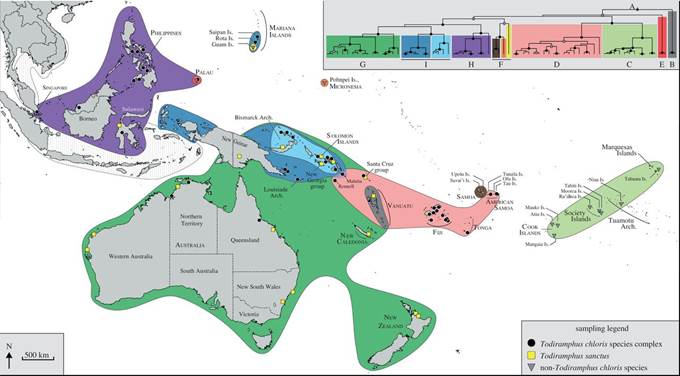For those with an evolutionary/genetic /biogeographic interest, there is a new OPEN ACCESS paper on kingfishers in the region.
Robin Hide
http://rsos.royalsocietypublishing.org/content/2/2/140375
Michael J.
Andersen et al. 2015 “Rapid diversification and secondary
sympatry in Australo-Pacific kingfishers (Aves: Alcedinidae: Todiramphus).” Royal Society Open Science Feb.
Abstract
Todiramphus chloris is the most widely distributed of
the Pacific's ‘great speciators’. Its 50 subspecies constitute a species complex that is distributed over 16 000 km from the Red Sea to Polynesia. We present, to our knowledge, the first comprehensive molecular phylogeny of this enigmatic radiation of kingfishers.
Ten Pacific Todiramphus species are embedded within the T. chloris complex, rendering it paraphyletic. Among these is a radiation of five species from the remote islands of Eastern Polynesian, as well as the widespread migratory taxon,
Todiramphus sanctus. Our results offer strong support that Pacific Todiramphus, including
T. chloris, underwent an extensive range expansion and diversification less than 1 Ma. Multiple instances of secondary sympatry have accumulated in this group, despite its recent origin, including on Australia and oceanic islands in Palau, Vanuatu
and the Solomon Islands. Significant ecomorphological and behavioural differences exist between secondarily sympatric lineages, which suggest that pre-mating isolating mechanisms were achieved rapidly during diversification. We found evidence for complex biogeographic
patterns, including a novel phylogeographic break in the eastern Solomon Islands that separates a Northern Melanesian clade from Polynesian taxa. In light of our results, we discuss systematic relationships of
Todiramphus and propose an updated taxonomy. This paper contributes to our understanding of avian diversification and assembly on islands, and to the systematics of a classically polytypic species complex.


